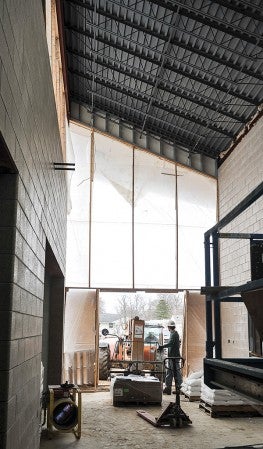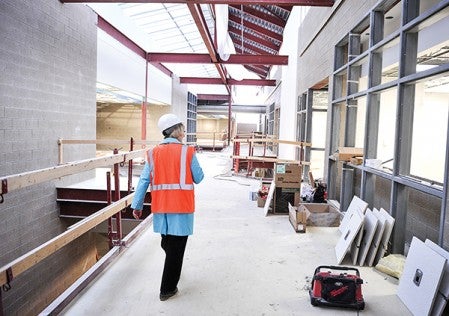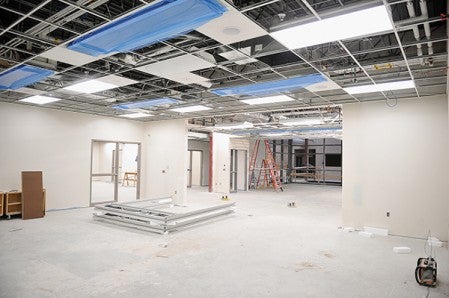Holton school taking shape, construction scheduled for completion in July
Published 12:06 pm Thursday, May 2, 2013
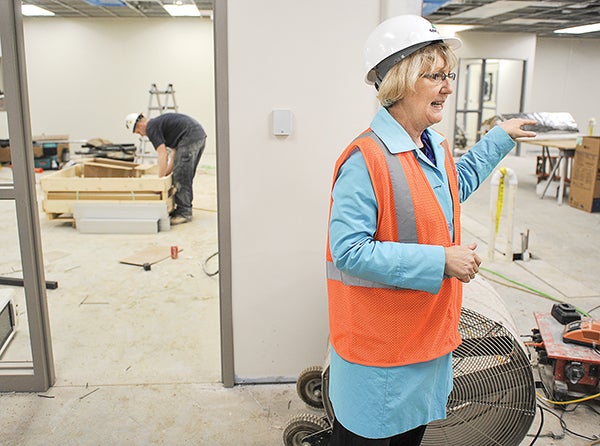
Jean McDermott, principal for the new I.J. Holton Intermediate School, talks about the layout of the new school during a tour for media Wednesday afternoon. — Eric Johnson/photodesk@austindailyherald.com
Jean McDermott stepped over building supplies, mud still caked to her shoes from the recent rain. The principal of the upcoming I.J. Holton Intermediate School navigated through rooms full of workers Wednesday afternoon and pointed out the building’s upcoming features.
“There are so many different things that are going on here,” she said.
Once a skeleton of empty passages and rooms, the school is inching closer to a July 15 completion date. Adding furniture will take two weeks, followed by several more weeks of getting supplies and teachers situated.
For now, piping, hanging wires and building materials lay scattered about each room. A chunk of the main entrance was left open, so workers could move larger supplies in without fitting them through door frames. The two main stairways, connecting the fifth-grade-centric ground floor with the sixth-grade domain upstairs in the open, naturally lit main hallway, had yet to be put in.
“It’s been really nice to be able to see it actually come to fruition here,” said assistant principal Lynn Hemann, who will be on-site full time along with McDermott starting around the end of June.
Classrooms at the school are built for flexibility, McDermott said. Science labs, for example, have garage doors that retract to make a room larger to suit group projects, or close for several separate learning spaces.
“I like the fact that so many rooms have multiple purposes,” said William Tyra, superintendent with Amcon Construction.
Certain walls by classrooms will be made of the same material used for marker boards, allowing students and teachers to write directly on them, McDermott said.
The classrooms are also designed to be energy-efficient, with lights that sense whether a room is occupied and turn on or off accordingly. Other light fixtures will take into account how much natural light comes into the building, and dim to only meet what is necessary.
Hemann said a green approach not only would save on the building’s electricity bill, but fit well with the engineering part of the curriculum.
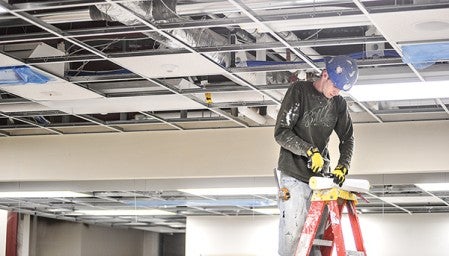
Anthony Smith of Mechanical Insulating, readies insulation ducts, cooling and heating pipes in I.J. Holton Intermediate School Wednesday afternoon.
Learning tools extend beyond the confines of the classroom. Common areas near groups of classes give teachers the option to bring different groups of students together.
Students will even find learning tools in the flooring, as a long yardstick will be painted along the floor, along with small animal footprints students can hunt for and discover.
“We’ve planted footprints of some of our native Minnesota species,” McDermott said.
The building is centered around the idea of learning opportunities at every turn. Even the elevator, which right now is an empty well, will have glass windows on either side, allowing students to see the inner workings as the machine operates.
In the music rooms, as with the smaller practice rooms, acoustic tile laid along the ceiling will help manage the sound of ensembles playing instruments. Gesturing to his surroundings in the orchestra/choir room, Tyra said the slanted alignment of connecting walls was intentional.
“For acoustical reasons, there are very few right angles in the room,” he said.
Four special education rooms are also part of the building, and each caters to the specific needs of a student. One will house a washer, drier, stove and refrigerator, to help teach students basic living skills, while another caters specifically to students with autism.
At opposite ends of the school are the school bus and car drop-off sites, which aim to help control the traffic of students coming to school in the morning.
While there are only about 750 students set to attend school in the fall, McDermott said the building was built with an 880-pupil capacity to allow for expected growth.
“Right now we’re actually going to open with a few empty rooms,” McDermott said.
The construction project has been a challenge so far, Tyra said, but everything was on schedule and coming together well thanks to the workers’ efforts.
“We’ve got some very good people here,” he said.
While the actual building construction will finish in about 2 1/2 months, the work doesn’t end there.
“The tweaking, especially the heating and cooling systems, will take some time,” he said.
A relatively mild winter helped crews keep on schedule with construction, Hemann said. By covering small patches of the exterior in protective plastic, crews were able to keep working on the outside. Between 70 and 100 workers are on-site during a typical work day.


